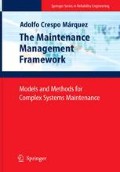Access this chapter
Tax calculation will be finalised at checkout
Purchases are for personal use only
Preview
Unable to display preview. Download preview PDF.
14.5 References
Duffua SO, Raouf A, Campbell JD, (2000) Planning and control of maintenance systems: Modelling and analysis. New York: John Wiley and Sons.
Chase RB, Aquilano NJ, (1977) Production and operations management. A life cycle approach. Homewood, Illinois: Irwin.
Chang LY, (2002) WinQSB: Software and manual, Version 2.0. New York: John Wiley and Sons.
Liu J, Rahbar F, (2004) Project time-cost trade-off optimization by maximal flow theory. Journal of Constuction Engineering and Management, 130(4): 607–609.
Ford LR, Fulkerson DR, (1962) Flows in networks. Princeton, NJ: Princeton Univ. Press.
Hoyland A, Rausand M, (1995) System reliability theory. Models and statistical methods. New York: John Wiley and Sons Inc.
Pidd M, (2003) Tools for thinking. Modelling in Management Science. 2nd. Edition. Chichester, England: Wiley.
Marseguerra M, Zio E, (2002) Basics of the Monte Carlo method with applications to system reliability. Hagen, Germany: LiLoLe-Verlag GmbH.
Chen F, Drezner Z, Ryan JK, Simichi-Levy D, (1999) The bullwhip effect: managerial insights on the impact of forecasting and information on variability in a supply chain. In: Mayur, Ganeshan and Magazine (Eds.) Quantitative models for SCM. International Series in Operations Research and Management Science, 17: 419–439.
Sanders NR, (1994) Forecasting practices in United-States corporations. Survey results. Interfaces, 24(2): 92–100.
Makridakis S, Wheelwright S, Hyndman R, (1998) Forecasting methods and applications. New York: John Wiley and Sons.
Evers PT, (1999) The effect of lead times on safety stocks. Production and Inventory Management Journal, 40(2): 6–10.
Tersine RJ, (1994) Principles of Inventory and Materials management. 4th. Edition. Englewood Cliffs. NJ. Prentice-Hall.
Aucamp DC, Barringer RL, (1987) A table for the calculation of safety stock. Journal of Operations Management, 7: 153–163.
Tversky A, Kahneman D, (1974) Judgment under uncertainty. Heuristics and biases. Science, 185: 1124–1131.
Sterman JD, (1989) Modelling managerial behaviour: Misperceptions of feedback in a dynamic decision making experiment. Management Science, 35(3): 321–339.
Dohi T, Kaio N, Osaki S, (2000) Basic preventive maintenance policies and their variations. In: Ben-Daya M, Duffuaa SO, Raouf A, (Eds.) Maintenance Modelling and Optimization, 155–183. Boston: Kluwer Academic Publishers.
Van der Duyn Schouten FA, Vanneste SG, (1995) Maintenance optimization of a production system with buffer capacity. European Journal of Operations Research, 82:323–338.
Lacksonen T, (2001) Empirical comparison of search algorithms for discrete event simulation. Computers and Industrial Engineering, 40(1–2): 133–148.
Bengu G, Haddock J, (1984) A generative simulation-optimization system. Computers and Industrial Engineering, 10: 301–313.
Nelder JA, (1965) A simplex method for function minimization. Computer Journal, 7:308–313.
Glover F, (1986) Future paths for integer programming and links to artificial intelligence. Computers and Operations Research, 5: 533–549.
Aarts E, Lenstra JK, (1997) Local search in combinatorial optimization. Chichester, England: Wiley.
Kirpatrick S, Gelatt CD, Vecchi MP, (1983) Optimization by simulated annealing. Science, 221: 671–680.
Goldberg DE, Deb K, (1991) A comparative analysis of selection schemes used in genetic algorithms. Foundations of Genetics Algorithms, 1: 69–93.
Powell MJD, (1964) An efficient method for finding the minimum of a function of several variables without calculating derivatives. Computer Journal, 7(2): 155–62.
Ventana System Inc, (2006) VENSIM: Ventana simulation environment. Version 5.6. Cambridge, MA.
Okamotoa M, Nonakaa T, Ochiaia S, Tominagaa D, (1998) Nonlinear numerical optimization with use of a hybrid genetic algorithm incorporating the modified Powell method. Applied Mathematics and Computation, 91(1): 63–72.
Coleman BJ, (2000) Determining the correct service level target. Production and Inventory management Journal, 41(2): 19–23.
Ignizio JP, (1976) Goal programming and extensions. Lexington, MA: Lexington Books.
Saaty TL, (1990) How to make a decision. The analytic hierarchy process. European Journal of Operational Research, 48: 9–26.
Crespo Marquez A, Gupta JND, Sánchez Herguedas A, (2003) Maintenance policies for a production system with constrained production rate and buffer capacity. International Journal of Production Research. 41(9): 1909–1926.
Crespo Marquez A, Gupta JND, Ignizio J, (2006) Improving preventive maintenance scheduling in semiconductor fabrication facilities. Production Planning and Control. 17(7): 742–754.
Rights and permissions
Copyright information
© 2007 Springer-Verlag London Limited
About this chapter
Cite this chapter
(2007). Models to Deal with Maintenance Scheduling Issues. In: The Maintenance Management Framework. Springer Series in Reliability Engineering. Springer, London. https://doi.org/10.1007/978-1-84628-821-0_14
Download citation
DOI: https://doi.org/10.1007/978-1-84628-821-0_14
Publisher Name: Springer, London
Print ISBN: 978-1-84628-820-3
Online ISBN: 978-1-84628-821-0
eBook Packages: EngineeringEngineering (R0)

